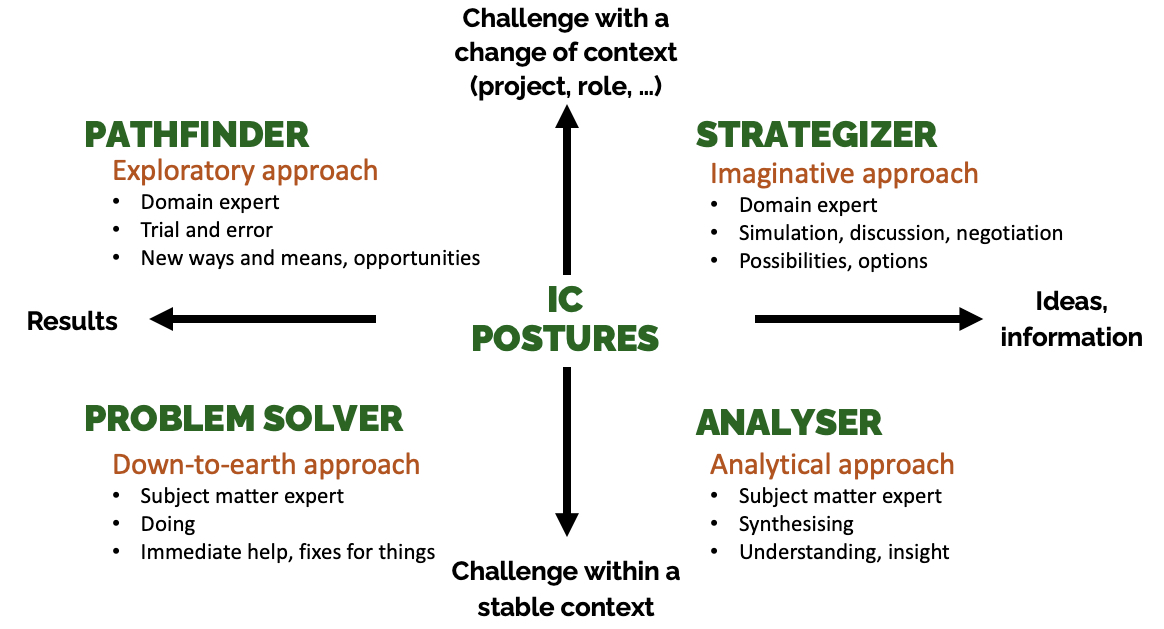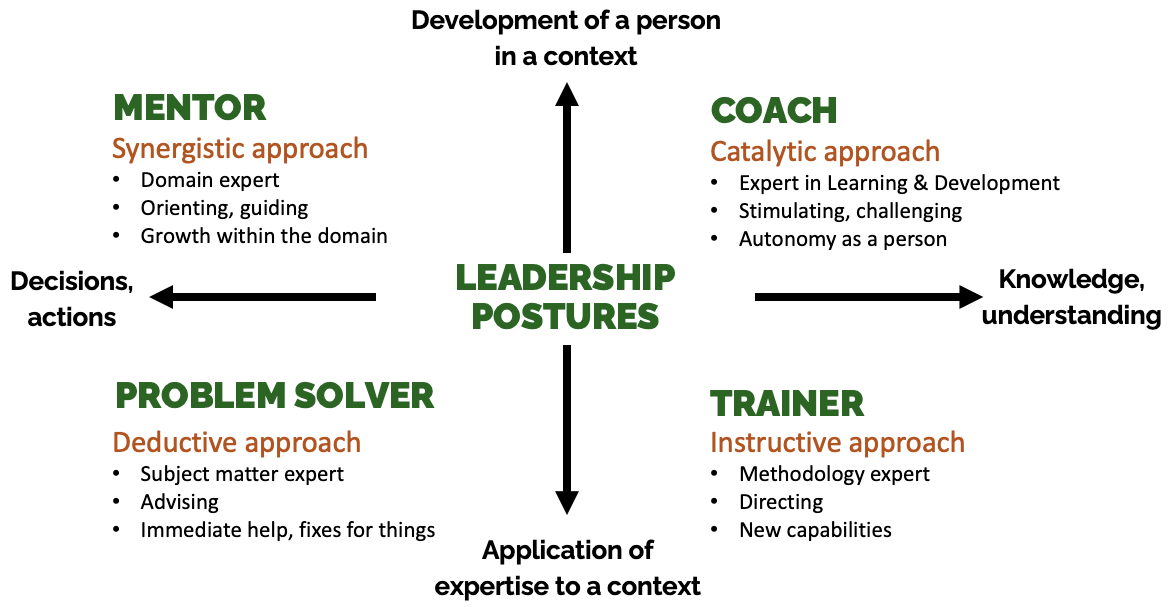Possible Postures for Managing Up
Here’s some good news about diverse communication skills, applicable to any context: if you question professional people about this topic today, you’ll get some excellent answers – significantly better, I believe, than what you could have expected a generation ago. Somehow, something’s improving.
As evidence of this, I cite a flash survey performed by my colleague, Suraj Ethirajan, as part of our preparation for a podcast on “managing up”.
In brief, the replies showed that the world has moved on from the one I knew at the start of my career, 30+ years ago. Thankfully, a large percentage of us accept that the workplace can’t be reduced to binary concepts and simplistic classifications. We are not, after all, either managers or workers, leaders orfollowers, the judges or the judged.
We take on various roles, according to circumstances, and adopt different interaction styles according to the needs of the moment. Every moment, in fact, we have to find the appropriate doses of confidence and humility, balance attempts to influence with a willingness to accept other points of view, simultaneously show strength while acknowledging vulnerability.
In other words, we have come to favor a continuous mindset over a binary one.
Experiences of managing up
Of the four questions in the survey, I was most interested by the responses to “”What has been your experience of managing up?”. For example:
Have had mixed experiences – at a legacy company but in and R&D group, was able to better ensure project relevance to own career, but in a production job at a new age “360 feedback” company could not overcome politics to do the same.
and:
It depends. Some respected and agreed on my approach vs. Some are more micro manager style. I think it’s based on the trust level and the boss’ confidence that I’m not stepping into their territories.
and also:
Have has good and bad experiences. Good experience is managers listening to your feedback seriously and making compromises on their decisions based on it.
This last comment clearly states one of the main goals of managing up – getting listened to. All three give a sense of the challenging nature of the practice.
Start with a situational approach
Although it’s perfectly appropriate for a junior to try to influence the decisions of more senior folk, their approach has to take account of the expectations and sensitivities related to hierarchy. The same goes for senior-junior and peer-peer interactions, of course.
To do this, it helps to have a good understanding of the several postures that Individual Contributors (ICs) and Manager-Leaders (M-Ls) can adopt. We often hear about “situational management” [Hersey-Blanchard] and the need for M-Ls to adapt their posture and communication style to circumstances, but the same is true for ICs !
Suppose that an IC receives a request of some sort. If they are asked to produce some kind of result or fix for something in the scope of their regular duties, then they take the Problem Solver posture. If, on the other hand, they are asked for information or ideas, then an Analyzer posture would be more appropriate.
Sometimes, however, the scope stretches beyond regular duties – when new projects are coming up, when a crisis looms or when there is substantial change to cope with, for example. If immediate, practical solutions are called for, then the IC may take a Pathfinder posture, using their expertise and trial/errors methods to find a way through an evolving problem space. If, on the other hand, the primary goal is to understand and plan, then a Strategizer posture would be more appropriate.
These two paragraphs are summarized in the diagram below:

In introducing this model, I used the example of an IC receiving a request, implying that they would adopt one of the four postures mentioned in reaction to that request. However, the postures are equally relevant when taking a proactive stance and when managing up, as we’ll see in a moment. But before we return to managing up, let’s consider a similar scheme for M-L postures.
Leadership Postures are not only for Manager-Leaders to use
The approach or posture adopted by M-Ls will depend on whether the circumstances call for their collaborators to decide/act or whether they need more knowledge/understanding. This consideration is represented by the horizontal axis in the following diagram:

The appropriate posture also depends on the maturity of their collaborators with respect to the task in hand. If this is low, the M-L will adopt a Problem Solver posture and either direct operations in detail (in extremis, rolling up their sleeves and doing it themselves) or a Trainer posture where they explain how to get the thing done. If, on the other hand, the collaborators have a good level of maturity with respect to the subject matter, then an M-L would take an approach that allowed them to further develop their autonomy. A Mentoring posture would help them develop as professionals in a particular domain while a Coaching posture would encourage the collaborator grow as a person, independent of any particular area of technical expertise.
My summaries of these eight postures are, I fear, rather brief, but I hope that they illustrate the following point: both ICs and M-Ls have the freedom and responsibility to adopt a range of postures according to the needs of the moment. These needs will be determined by what there is to do and the people that they are interacting with.
Note that an M-L is also an IC when it comes to interactions with their own boss, and so they need considerable “posture agility” (8 postures!). However, when we consider how this model relates to managing up, we see that ICs sometimes have to adopt Leadership Postures – so they have to be pretty nimble too!
Individual decisions on managing up tactics can leverage concepts of posture
Let’s use the above framework and vocabulary with some managing up examples in order to deepen our understanding of the practice of managing up.
- Getting the resources or support required
- The IC is asked to produce 6 widgets and a dingdong by Friday night, a request that invites them to adopt a Problem Solver posture (result-oriented, producing something new, in line with their existing responsibilities).
- In this posture, I suggest that managing up has two elements:
- Convincing the M-L of a commitment to the task (so that the request for resources and support is not interpreted as an excuse for future failure)
- Strongly linking the availability of resources and support to the delivery of 6 widgets and a dingdong by Friday. If this can be done, the M-L will be motivated to find the resources and support in question … and this motivation will have been triggered by the IC (managing up!).
- Setting expectations on what is possible (time, objectives, …)
- An M-L asks an IC to produce a presentation on the possible uses AI in their business area of bicycle tire manufacturing, inviting the IC to take a Strategizer posture (to produce ideas and information for a new context)
- Managing up in order to clarify what may and may not be possible is important when in this position, since the outputs are far less clear-cut than in the previous example.If the M-L misunderstands the IC’s commitment, they may be disappointed and they could pass on the wrong information to others (contamination).
- Simply stating what is possible does not seem to be adequate. For the IC to put the M-L is in a position to communicate in a sufficiently nuanced way about AI in bicycle tire manufacture, they may have to use the Leadership posture of Trainer or even Coach. Since these are postures that the M-L might not be expecting of the IC, they should perhaps explain why this switch is needed.
- Spontaneous help
- The IC happens to have an intimate knowledge of the Japanese culture and the M-L is being exposed to it for the first time. The IC can see that the M-L needs mentoring.
- In these circumstances, the IC can see the need to take a mentoring posture and, before they can do so, they need to agree this with their M-L. A contract is needed – a verbal one at least – not only to avoid misunderstanding about the role the IC will play, but also to agree on a quid pro quo! (that the IC’s contribution be recognized at the next review, for example).
- This example illustrates the importance of (1) being conscious of postures in order to articulate any change in them, especially unusual ones, (2) openly discussion situations where, as an IC, it makes sense for you to adopt one of the Leadership postures.
- The IC happens to have an intimate knowledge of the Japanese culture and the M-L is being exposed to it for the first time. The IC can see that the M-L needs mentoring.
Many other examples come to mind. You might like to consider the appropriate “posture dance” for the following:
- Pushing back on requests
- An IC resists a request to work out the potential market for a product they believe to be infeasible, obliging the M-L to rethink.
- Giving and requesting feedback
- The IC gives positive or conditional negative feedback to their M-L, putting them in a position to strengthen their skills.
- The IC requests feedback on a specific point, thus guiding the M-L in the way that they mentor and coach the IC.
- Expressing feelings and needs
- The M-L has been clumsy in their handling of the IC and the latter explains how this has affected them. Without judging the M-L, they therefore give them the information that they need to improve in their role.
- Coach example
- The IC can see that the M-L is struggling with a crucial life skill and feels in a position to support them. How to deal with a bereaved team member, for example.
- Problem Solver (at the Leadership level)
- The IC can see a solution to one of the M-L’s own problems, even though this type of problem is outside of the IC’s normal remit. Perhaps the IC is in a better position to analyze and understand a particular set of political issues than the M-L, even though the IC’s normal role is writing software.
- Trainer example
- The M-L needs to learn something – a scripting language, an analysis technique, the use of an online tool – in order to better manage or lead the team. The IC is in a position to teach them.
In the latter three examples, managing up can be especially delicate if the M-L feels that the IC is encroaching on their responsibilities, challenging their credibility. It is therefore important that the IC be aware of the posture that they are adopting, that they explain their intentions and that they come to an explicit agreement with their M-L on this aspect of their work together.
Let’s continue to improve
It seems that, as a community, we have learnt a lot about effective communication over recent years. This includes awareness of best practices, rights and responsibilities related to collaboration and the complex nature of roles and postures. It shows up in professional surveys, as we see above, and though awareness is not the same as practice, behaviors are surely following the same encouraging trend.
The framework of postures presented above is inspired by innumerable experiences, conversations, articles and books for which I am immensely grateful, though equally incapable of citing. I hope that you find it helpful for structuring your own thoughts, for building upon it and improving it in your turn.
Andy Betts
220321

